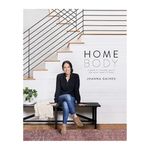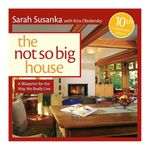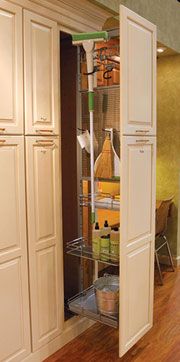A Buyer’s Guide to Kitchen Cabinets
An inside look at which construction details are most durable, what hardware is worth paying for, and why inside corners don’t have to be dead zones
Magazine Extra: Make it your own. Read Gary Striegler’s Souped-Up Stock Cabinets to learn strategies for arranging your cabinets, plus details on how to dress them up with moldings, carvings, furniture feet, and other decorative elements.
Cabinet manufacturers from all over the country rolled out their best stuff last spring for the kitchen and bath industry’s annual trade show, staged at the cavernous Las Vegas Convention Center. Sprinkled among booths showcasing bathtubs and appliances were kitchen cabinets of every style, from Arts and Crafts in quartersawn oak to modern in Macassar ebony. Wellborn Cabinet Inc. alone offered nearly 1500 different combinations of finish and door styles.
Yet for all this diversity, every cabinet is made from the same basic components. Where they differ, and why prices vary so widely, can be traced to what’s under the hood: materials, hardware, and construction techniques. Although manufacturers offer such a wide price range that they can cater to budgets of any size, spending more money usually means greater durability, better hardware, a nicer fit and finish, and more flexible designs.
A competitive scramble among stock and semicustom cabinet manufacturers gives buyers more choices than ever. Stock cabinets, the most economical, are still essentially an off-the-shelf commodity with the fewest options in finish and materials. Semicustom cabinets allow buyers to specify most but not all features. Prices vary accordingly.
While cabinet sizes in both categories tend to be standardized (available for the most part in 3-in. increments), manufacturers have tried to make it easier for buyers to order the options they want even on a modest budget.
Custom cabinets can be whatever a buyer is willing to pay for, usually with the longest lead time and the highest prices.
In the end, how a cabinet is made is a lot more important than what it’s called. The essential elements to consider are box construction, drawers, doors, hardware, and finish.
Learn More:
 Semicustom
Semicustom  Plain & Fancy Custom
Plain & Fancy Custom
Go for plywood boxes, even if you’ll never see them
A box, or carcase, is the foundation of any kitchen cabinet. Hidden behind face frames and end panels, the box is often unseen, but everything depends on its structural integrity.
Where you’ll find significant differences is in the materials that go into the sides and back of the box. Economy cabinets usually are made of particleboard covered with a thin layer of vinyl printed with a wood-grain pattern. Particleboard is inexpensive, which helps to keep the cost of the cabinets down, but it doesn’t hold screws as well as plywood, and it is susceptible to water damage. If the vinyl surface tears or becomes delaminated, there’s no way to repair it.
Melamine is a type of pressed wood-fiber panel that’s often used for cabinet boxes because the plastic layer on top is easy to keep clean. It’s heartier than the vinyl-covered particleboard in economy cabinets, but the surface can chip if it’s abused.
Plywood costs more, but it’s inherently more robust. Screws that attach hinges, drawer slides, and other hardware are less likely to be pulled out over time, and the surface can be repainted or refinished if it’s damaged.
Cabinet sides range in thickness from 1/2-in. to 3/4-in. Thin walls can make a cabinet feel cheap, and they offer less meat for shelf pins and hardware screws to grab. Plywood a full 3/4-in. thick makes a solid, long-lasting box that can support heavy counters without complaint.
Cabinet backs aren’t that important. Even good-quality cabinets might have backs made of 1/4-in. material. There is a structural purpose—the back prevents the cabinet from racking—but unless the countertop is unusually heavy or drawer hardware is to be mounted directly to the back, a panel that’s ¼ in. thick shouldn’t be a drawback. Still, plywood is a better choice than hardboard.
Face frames also help to make the box sturdy. They are usually made from the same hardwood as the drawer faces and doors. Look for gap-free joints between the pieces that make up the frame. When inside edges around door and drawer openings are sanded smooth and joints are tight, it’s an indication the frame was made with care. In frameless cabinets (also known as European cabinets), doors and drawers hide the front of the box completely. Without a frame to help keep the box rigid, it’s more important than ever to buy a cabinet made of high-quality 3/4-in. material.
Design with you in mind
 Krysta S. Doerfler
Krysta S. Doerfler
The same kitchen design doesn’t work for every homeowner, so a new generation of designers have sharpened their pencils to match their products with the lifestyles of potential buyers. whether you’re a first-time homeowner or a retiree, someone has been thinking about you.
In fact, heather argo, a designer for the cabinet manufacturer Kraftmaid, invented “Edward” to help design a kitchen for gen-y buyers. a 20-something lawyer in Philadelphia, Edward likes games and electronics, doesn’t cook much, and needs lots of storage for bottled water and ready-to-eat food. the result? a modern kitchen with a clean, white finish, contemporary hardware, a big TV cabinet, and a raised circular counter for eating or playing cards.
Kraftmaid’s layout for “active seniors” includes a built-in desk with an adjacent full-height pullout for office and cleaning supplies. Armstrong, another manufacturer, has taken a similar “lifestyle solutions” approach. among its offerings are a cabinet doubling as a children’s play area and a chef’s zone that keeps cooking tools and other accessories within a couple of feet of the cooktop. Playtime. With toys and a writing surface close at hand, Armstrong’s play center can be a part of kitchen activity, but not underfoot.
Playtime. With toys and a writing surface close at hand, Armstrong’s play center can be a part of kitchen activity, but not underfoot.
Krysta S. Doerfler
Dovetails are stronger, so the drawers last longer
Hardwood drawer sides that are 5⁄8 in. or 3/4-in. thick are a good idea on all but the lightest and smallest drawers. Material that’s only 1/4-in. thick, especially if it’s particleboard, is not as dependable.
Drawer bottoms are often 1/4-in. thick, and again, plywood is a better choice than particleboard or hardboard. On cabinet pullouts that carry a lot of weight, a 3⁄8-in. or even a 1/4-in. plywood bottom is less likely to sag over time.
Well-made dovetail joints make the most-durable drawers. A poorly made dovetail, on the other hand, is no better than a poorly made anything else. There should be no gaps in the interlocking parts, and the joint should be sanded and finished carefully. Particleboard drawers are typically glued and stapled at the corners and don’t stand up well to heavy use.
Wood drawers are by far the most common, but metal-sided drawer boxes like Blum’s Tandembox or Ikea’s ready-to-assemble cabinets have a sleeker, more contemporary look. They’re well adapted to frameless cabinets, and some come with integrated full-Armstrong extension drawer slides and a soft-close feature. They can be paired with a variety of dividers and organizers.
Solid wood doesn’t always make the best door
Cabinet doors come in two basic types: frame-and-panel or slab. Frame-and-panel doors are the traditional choice with face-frame cabinets and are available in dozens of styles. The frames are typically made of solid wood, while the panels might be solid wood or veneered MDF (medium-density fiberboard).
Veneered panels are flat and stable, and furniture history proves there is nothing structurally inferior about them. However, they might age differently than a solid-wood frame, resulting in a contrast between the two. This is an issue only with woods that change dramatically with age, such as cherry, but the concern is worth considering.
Solid-wood panels are more likely to shrink and expand with changes in humidity, but won’t show color differences and won’t delaminate. Solid-wood panels are probably worth their slightly higher cost.
Slab doors are either glued-up solid wood or veneered MDF and are typically used with frameless cabinets. A substrate of MDF should help to keep the door flat and free of warp. A solid-wood door that’s 18 in. or 20 in. wide might cup or twist over time.
No matter what the style, look at the doors carefully. On frame-and-panel doors, the joints should be tight and free of gaps when the cabinets are new. If the panels are glued up from solid wood, look for a good match in grain and color between adjacent boards. No cross-grain sanding marks should be visible on either the inside or outside of the door, and the finish should feel soft and silky.
If the door has a glass panel, the fit between glass and wood should be neat, and you should not find globs of glue or caulk oozing out of the seam.
Hardware should stand up to wear and tear
Hardware manufacturers have pulled out all the stops to make cabinet interiors more functional and user-friendly. Most cabinet companies buy hardware from the same manufacturers, so no matter what brand of cabinet you buy, you should have a good menu of hardware to choose from.
Most drawers and pullouts ride on side-mounted ball-bearing metal slides. A variety of types are available as full extension or three-quarter extension, meaning the drawer either comes all the way out or stops with about a quarter of its depth still buried inside the cabinet. Full-extension slides are well worth the extra cost.
Slides are rated by the weight they are designed to carry, typically 75 lb. or 100 lb. Slides rated at 75 lb. should be fine for all but the largest and heaviest drawers, but roll-out pantry shelves or drawers for heavy pots and pans or appliances do better with beefier slides.
Undermount slides are becoming increasingly common. They are attached to the bottom of the drawer and are hidden by the drawer sides, making the cabinets look more like furniture.
Many cabinet companies now equip their drawers with a soft-close mechanism made by Blum called “Blumotion.” It grabs the drawer near the end of its travel, slows it down, and then gently brings it to a stop—a great idea if you live in a house where people tend to slam drawers closed.
Good luck finding cabinets with traditional butt hinges. European-style door hinges, or cup hinges, have taken over. They are available for both frameless and face-frame cabinets, and because they allow a variety of adjustments, these hinges make it easy to hang even finicky inset doors. The Blumotion soft-close feature is also available for hinges.
Fancy finishes are durable, too
Manufacturers devote a lot of energy to cabinet finishes, what might be the most fickle part of the business as designers try to gauge shifting buyer preferences. The tremendous diversity of painted, glazed, stained, and distressed finishes is a testament to the industry’s effort to appeal to any taste.
In general, the least-expensive finishes are simple clear coats. The most expensive are multilayered glazes and paints, crackle finishes, and rub-through painted surfaces that take more time to execute at the factory. Painted surfaces are somewhat less durable than clear finishes and might show slight gaps in joinery more readily. Glazed-paint finishes can help to disguise these minor flaws.
For clear finishes, most manufacturers use a conversion varnish, a tough two-part catalyzed coating. Old-schoolers might prefer lacquer because it’s more repairable, but catalyzed finishes are extremely durable and are now the norm.
Where you’re likely to find differences is in the quality of application. The best finishes start with thorough surface prep, meaning you should see no sanding marks of any kind on the finished surface. Whether the surface is matte or glossy, it should be smooth and blemish free. Look along edges and inside doors, using your fingers as well as your eyes.
In the end, finishes are largely a matter of personal taste. Basic, no-frills finishes should provide a long service life, but if you want something more elaborate and are willing to pay for it, you have plenty of options.
Innovations in Kitchen Storage
Ingenious storage solutions are not limited to corners. designers have been busy conjuring up all kinds of pull-out bins, shelves, and mini-closets that get the most out of every inch of cabinet space.
Photos by Charles Miller, except where noted.
Fine Homebuilding Recommended Products

Homebody: A Guide to Creating Spaces You Never Want to Leave

Not So Big House

All New Bathroom Ideas that Work































View Comments
Your writer appears to be down on IKEA. 25 year warranty on cabinets. 10 year warranty on faucets. 5 year warranty on appliances (that are all made by Whirlpool that only give 1 year on their own appliances.) I don't know any manufacturer/kitchen design studio that gives these type of warranties.
There's even a company with 5 showrooms across the U.S. that makes high end doors and drawers only for IKEA cabinets. (Do a search. You'll find it.)
...and in 25 years styles will have changed so much that a new kitchen will likely be on the new home owners shopping list.